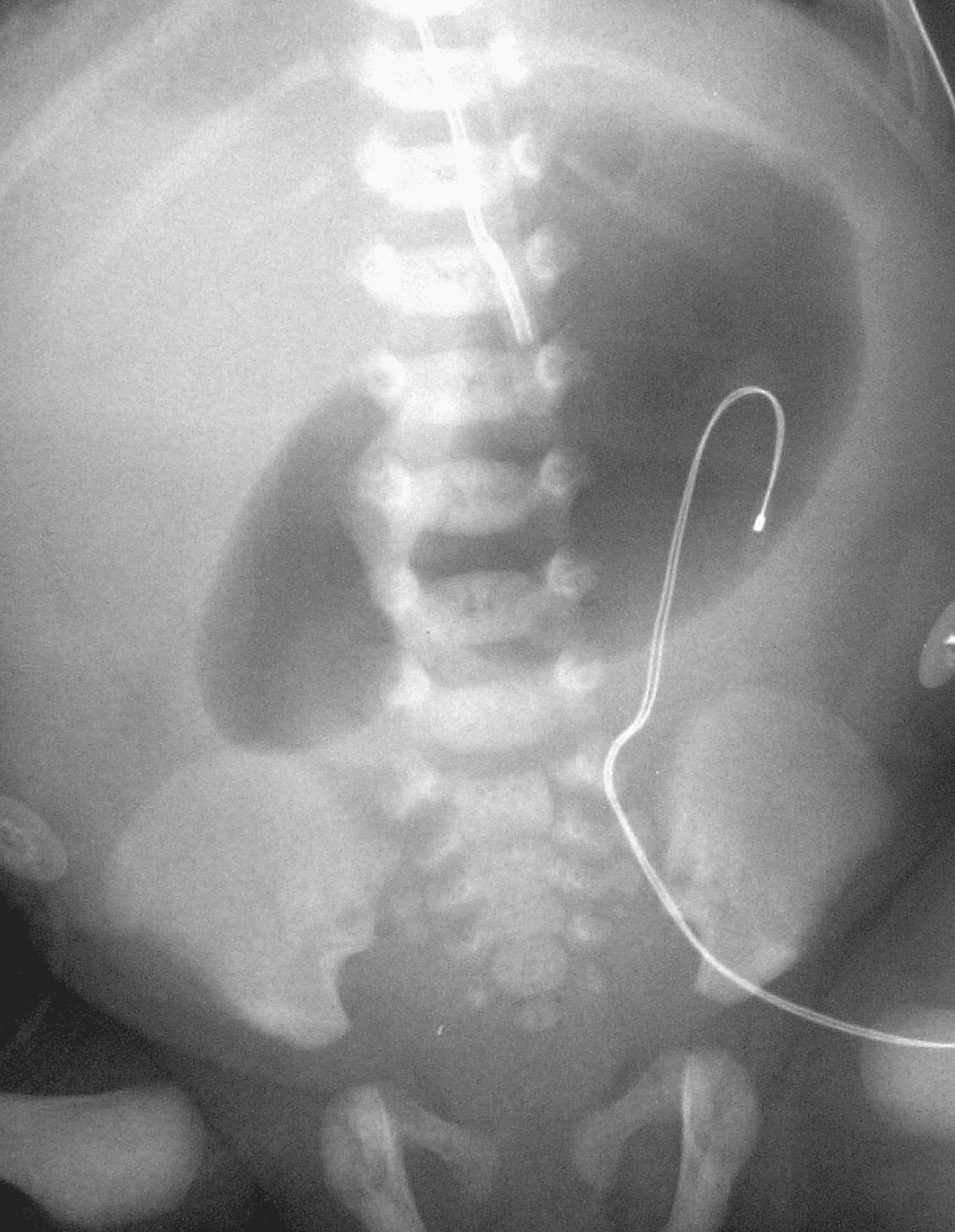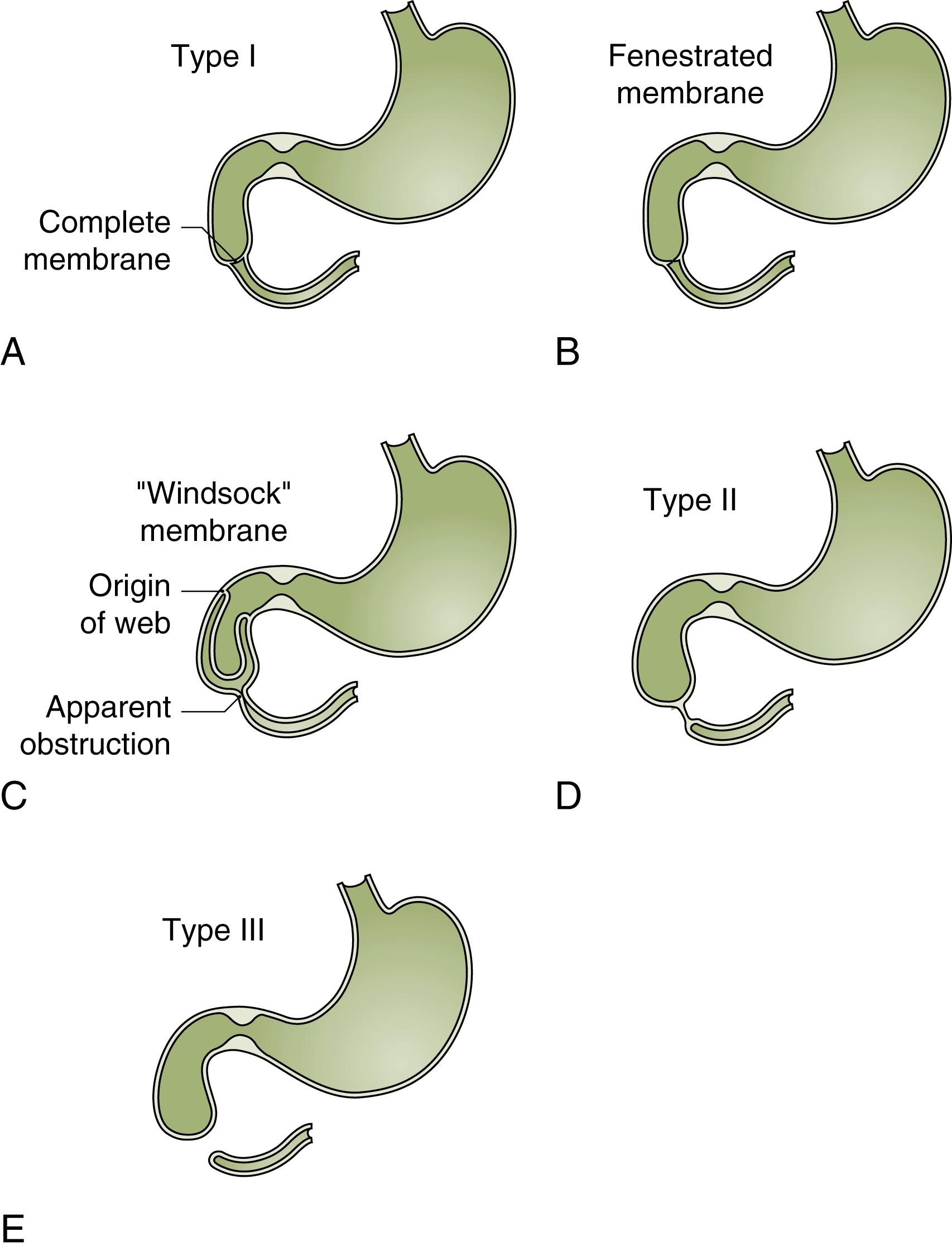Physical Address
304 North Cardinal St.
Dorchester Center, MA 02124
Intestinal atresia and stenosis are common causes of neonatal intestinal obstruction and can affect any portion of the gastrointestinal tract. “Atresia,” derived from the Greek word atretos, means not perforated. This term is used to describe a congenital absence or pathologic closure of a body opening or passage, and these comprise approximately 95% of congenital gastrointestinal obstructions. When used to describe gastrointestinal anatomy, this word refers to luminal discontinuity resulting from an anatomic obstruction. “Stenosis,” derived from the Greek word stenos , means narrow. This term refers to a partial obstruction of the lumen that allows for incomplete passage of material and accounts for approximately 5% of these cases.
In 1733, Calder was the first to describe duodenal atresia as a potential cause for intestinal obstruction. It was not until almost two centuries later, in 1916, that Ernst reported the first surgical survivor with this abnormality. Fortunately, the mortality rates have improved with refinements in pediatric anesthesia, advancements in surgical technique, and improved perioperative management of newborns. Long-term survival rates are now as high as 90%, with operative mortality as low as 3% within 30 days of surgery. Morbidity and mortality typically results from other associated medical conditions, such as congenital heart disease, short-bowel syndrome, prematurity, respiratory distress syndrome, and cystic fibrosis. Congenital heart disease and trisomy 21 are the most common of these associated conditions, each occurring in approximately 30% of infants with duodenal atresia or stenosis.
In 1902, Tandler first proposed the commonly accepted theory that the etiology of duodenal atresia is a failure of luminal recanalization. The duodenum develops from the distal portion of the foregut and the proximal portion of the midgut beginning at about 4 weeks’ gestation. These portions of bowel grow rapidly and join distal to the origin of the biliary system. By 6 to 7 weeks’ gestation, the duodenal lumen is obliterated due to epithelial proliferation. By 8 to 10 weeks’ gestation, the duodenum normally recanalizes. Failure of this process most commonly occurs in the second portion of the duodenum; however, it may occur anywhere in the duodenum, including the preampullary location. Duodenal atresia or stenosis is thought to be secondary to failure of this recanalization process, unlike more distal intestinal abnormalities, which are most often attributed to ischemic injury.
Intrinsic duodenal and pancreaticobiliary anomalies often coexist, suggesting a potential mechanism linking them during early foregut development. Pancreatic buds develop from the duodenal endoderm during the fourth gestational week. The larger dorsal bud appears first, followed by the smaller ventral bud, which develops at the future site of the ampulla of Vater. As the duodenum undergoes clockwise rotation to form a “C-shaped” configuration, the ventral pancreatic bud rotates dorsally. Normally, these two buds fuse in the eighth gestational week. If the ventral bud fails to undergo complete rotation and remains anterior to the duodenum, this fusion process produces an annular pancreas.
Congenital duodenal obstruction occurs in approximately 1 in every 6000 births in the United States, whereas in Finland, the reported rate is significantly higher (1 in 3400). Approximately two-thirds of these cases result from intrinsic bowel pathology. In the remaining patients, obstruction can be associated with extrinsic compression from intestinal malrotation with Ladd bands, congenital bands without malrotation, preduodenal portal vein, gastroduodenal duplication, or pseudocyst of the pancreaticobiliary tree. While annular pancreas causes extrinsic compression, it is almost always associated with an intrinsic duodenal obstruction as well.
Duodenal atresia is often prenatally diagnosed on ultrasound in contemporary practice. Polyhydramnios is seen in 30% to 59% of children with duodenal atresia. Additional findings include a single sonolucent cyst in the upper abdomen without signs of intestinal obstruction during the second trimester, and with a dilated fluid-filled stomach and proximal duodenum during the third trimester.
Newborns with duodenal atresia generally present with emesis within the first 24 hours of life. The emesis is most often bilious in character, due to high incidence of postampullary (∼85%) obstruction. However, preampullary duodenal atresia is common enough that nonbilious emesis should not eliminate this diagnosis from consideration entirely. Physical exam findings generally reveal a physiologically stable patient. Most patients will present with some degree of abdominal distension, but without tenderness or an abdominal mass. Therefore, the presence of these findings may be concerning for an alternative cause of obstruction, particularly malrotation with volvulus. Plain radiographs typically show the classic finding of the “double-bubble” sign ( Fig. 57.1 ), resulting from gaseous distension of the stomach and proximal duodenum in an otherwise gasless abdomen. If the stomach has been decompressed through orogastric tube placement or vomiting, this finding can be reproduced radiographically by carefully injecting 30–60 mL of air through the orogastric tube.

Duodenal webs or stenosis can be more difficult to diagnose. The degree of feeding intolerance is variable depending on the severity of obstruction. Plain radiograph will show air in the gastrointestinal tract distal to the duodenum. Upper gastrointestinal contrast studies may have an appearance similar to that seen with malrotation or midgut volvulus. When in doubt, immediate surgical exploration is warranted. Occasionally, children with partial duodenal obstruction are diagnosed much later in life during evaluation for reflux symptoms, emesis, or failure to thrive.

Duodenal atresias are categorized according to their anatomic morphology. Type I duodenal atresias consist of obstruction due to a mucosal web or membrane. Occasionally, these membranes are fenestrated, allowing air and small amounts of enteric contents to pass distally. This type of duodenal atresia includes the “windsock” variant, in which the origin of the membrane may be as much as several centimeters proximal to the apex of the web. This appearance is thought to result from antegrade peristalsis and can be a pitfall for the inexperienced or occasional pediatric surgeon. It is important to note that the distal common bile duct and ampulla have proximity to or traverse the medial wall of this web. Type II duodenal atresias are characterized by a fibrous cord connecting proximal and distal ends of the discontinuous duodenum. Finally, type III duodenal atresias are the most infrequent form. This type of defect comprises two blind-ending bowel loops with no intervening mesentery. This form of atresia may be associated with biliary anomalies.
Initial treatment of an infant with duodenal stenosis focuses on stabilizing the infant. A peripheral intravenous line is established for crystalloid fluid administration. The patient should be restricted to receiving nothing orally, and an orogastric tube is placed for gastric decompression and to avoid aspiration. Next, the child should be evaluated for any associated anomalies that would affect the care of the child during anesthesia. An echocardiogram, in particular, is obtained for any child with a murmur or clinical evidence of Down syndrome.
After correction of any initial metabolic or respiratory compromise, the corrective operation can be done on an elective basis, as long as malrotation or midgut volvulus is not a concern. Laparotomy commences through a transverse supraumbilical incision. The abdomen is thoroughly inspected. If intestinal malrotation is found, a Ladd procedure is performed. Next, the hepatic flexure of the colon is mobilized medially, and the duodenum is completely exposed. Here the surgeon must note other variants including annular pancreas or preduodenal vein. These anomalies should be documented in the operative report but do not require immediate intervention. All lateral attachments to the retroperitoneum are released, fully mobilizing the entire duodenum. A transverse incision is made just proximal to the apparent point of obstruction. Optimal placement of this duodenotomy can be challenging in the setting of a partial obstruction. Subsequently, the ampulla should be clearly identified. Under loupe magnification, the gallbladder is compressed, and the location where bile enters the duodenum is identified. Intestinal continuity is restored with a duodenoduodenostomy. This anastomosis is usually performed in a Kimura diamond-shape (proximal transverse to longitudinal distal) fashion or side-to-side fashion; however, the reconstruction should be tailored to the individual’s anatomy. The principle is to bypass the point of obstruction. Prior to completing the anastomosis, a small, red rubber catheter should be passed distally to be certain there are no additional intraluminal obstructions. Historically, these are present in 1% to 3% of children, yet more recent reports suggest that they are present in less than 1% of cases. Laparoscopic repair using the same principles is being performed in some centers with good short-term (<30 day) outcomes. Further investigation with respect to long-term outcomes is needed before a minimally invasive approach can be considered standard.
When treating or suspecting a windsock deformity, passing the orogastric tube through the pylorus is helpful in identifying the origin of the obstructing web. The tube is advanced until resistance is met at the apex of the web. An indentation or puckering in the dilated proximal segment is identified, and this site corresponds to the base of the membrane. The duodenotomy should be made just proximal to this site, and the web should be excised laterally as the ampulla is frequently located along the medial wall. The duodenotomy is repaired with a layered closure. When the ampulla cannot be confidently identified in children with windsock or other deformities, a duodenoduodenostomy bypass is the most appropriate technique. If there is a significant size discrepancy between the dilated proximal and decompressed distal segments, the surgeon may elect to perform a tapering duodenoplasty on the lateral, antimesenteric border. There is real controversy among surgeons as to whether this modification improves outcomes.
Operative mortality for repair of duodenal atresia is approximately 4% and is most significant for children with complex associated heart anomalies. Postoperative care includes gastric decompression with an orogastric or nasogastric tube until the aspirate becomes clear and there is evidence of gastrointestinal function. During this period, infants are usually maintained on parenteral nutrition via peripherally inserted central catheter or central venous catheter. Once the gastric tube is removed, feeds are gradually advanced until the infant tolerates full enteral feeds. This often requires several weeks.
Become a Clinical Tree membership for Full access and enjoy Unlimited articles
If you are a member. Log in here